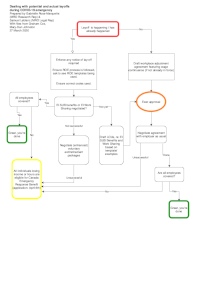Employment Insurance¶
Official Employment Insurance links¶
- Canada Emergency Response Benefit | Government of Canada
-
Make sure the local reviewed the CA and ensure the employer is following it.
- Be advised that there is already a delay receiving EI payments.
- The length of time will impact members depending on how long the wait is to receive the ROE and start receiving EI payments/income supports.
Canada Emergency Response Benefit¶
If a member has lost income because of COVID-19, the Canada Emergency Response Benefit (CERB) will provide you with temporary income support.
- The CERB will provide you with $500 a week for up to 16 weeks.
- The members can also earn up to $1000 a month while receiving CERB.
-
Please refer to the official CERB website for full information.
-
Members should continue to apply through the active online EI system until the new CERB system is online.
-
No matter how a laid-off workers applies (either through the EI system since March 15, now, or the CERB system when it is online), the member will receive the $2000 CERB benefit.
Note
These income supports should remain a final option for most CUPE locals since they involve a full layoff from the employer.
Declared Emergency Leave (DEL)¶
In Ontario, the new emergency leaves are also a factor. If the employer was ordered to shut down or employee told they cannot work due to COVID-19, that employee is eligible for the new leave. During the leave, benefits and pensions should continue, as with all statutory leaves.
In this situation, calculate the total compensation across all options. Will have to be workplace by workplace in these situations.
Recommended actions¶
Recommendations for union activists in locals dealing with potential layoffs:
-
Review CAs for layoff, leave provisions, and benefits.
-
Calculate total compensation for options below:
Options in order of preference for most locals:¶
-
Push for continuity of full wages/benefits. This is by far the best option, but it may not possible for a variety of reasons (e.g., significant revenue loss).
-
Negotiate EI Work Sharing agreements.
-
Negotiate wage top ups for those forced on layoff.
For employers who are facing revenue short-falls/reductions, but may have an interest in preserving income for temporarily laid off employees, they can top up EI.
In cases where the employer is work sharing agreements under El may also be possible. These agreements keep maintain health benefits and pension contributions for members.Warning
IE SUB Plans are not being accepted by Service Canada. While you should attempt to negotiate SUB and submit it to Services Canada (we are continuing to lobby the government on this).
So, in addition to any SUB agreement, wage subsidy of up to $1000 should be negotiated as a fall back (to be implemented now) for those on laid-off.
If the employer pays a SUB more than $1K they will lose CERB access the following two weeks.
So, you can only negotiate a support for laid off workers of up to $1K right now.
This is not clearly outlined in regulations/legislation, but we have gotten clear messages from CRA that they will not penalize the payment of $1K and under, since it is just wage that they would be able to get anyway.
But, Service Canada will not agree to any EI SUB agreements at all. So, the SUB is just a wage LOU and not an official EI SUB application to Service Canada. -
If in a lay-off position:
-
Attempt to negotiate (enhanced) voluntary exit/retirement packages and enforce any notice of lay-off required as well as ensure other job security measures are adhered to (bumping, redeployment, etc).
-
Follow all other aspects of layoff outlined in CA.
-
Demand Record of Employment process be followed through online IE portal
-
Ask to see ROE templates being used and make sure they are following proper codes for layoff.
-
Show workers how to apply online.
-
Make sure workers sign-up to the MyAccount service through the CRA; to get direct deposit and qualify for the CERB when it comes online.
-
Outline benefit to the members via notice of layoff with link to online application form and EI phone number. Suggestion for all to apply online.
-
General questions to ask employers¶
- How long will it take for ER to issue Records of Employment?
- Is the employer using the online system for ROE submission?
- Has the employer announced a full closure or is this just a group?
- Who will be providing this service if the employer is still open?
- If this is an outsourced service, how will the central employer be continuing to provide this service? How?
- Will laid-off employees be approached to provide in-house services?
Employee direction¶
Direction to all employees experiencing changes to employment status:
- Submit EI applications online.
- Collect all correspondence with employer.
- Collect all policy employer has sent.
-
Record employment situation previous to lay-off (PT/FT/Casual, hours, schedule).
-
Record every day:
- Why you are home.
- What you are doing at home (childcare, self-isolation, sick, etc.).
- Why the employer thinks you are at home (sick leave, vacation, personal days, etc.)
- Efforts made to gain EI, sickness, and/or income supports.
This will not be shared with employer, but the union will be collecting the information to file grievances and other complaints later.
